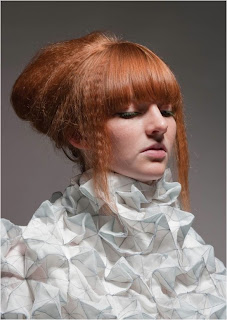The earliest history of this art form originated during the early seventh century, when this technique was introduced to Japan from China. This technique had a strong impact on Japanese culture; which influenced their architecture and everyday life. It wasn't until the 1600 that origami developed into the technique we know today, which people then created objects from the paper. This lead to it being passed down generation to generation and soon after the art form was named Origami.
This form has been used by many artists and with them doing so they have maintained the important part of Japanese culture and have spread this technique around the world.
Sunday 11 September 2011
Textile designers.....
These are a few origami inspired textile designers...


These were created by Elena Salmistraro which were inspired by an origami design.
Her work in these images show how she has incorporated the origami chatterbox to create layers and detail on her work.

These are some more origami-based textile work.


These were created by Elena Salmistraro which were inspired by an origami design.
Her work in these images show how she has incorporated the origami chatterbox to create layers and detail on her work.
This was created by Anna o'neill.
These textile samples are Richard Sweeney's, who is a origami-based textile designer.

These are some more origami-based textile work.
Origami inspired designers..
These are garments from Roxanne Zamani's Incongruous collection. Her collection is a collaboration of 100% silk and leather, which inspired the name of her collection. When it comes to her garments she makes sure they are wearable sculpture.
These garments are both from Amaya Arzuaga the garment on the left is from her s/s 11 collection which reminds me of the shape of insect wings and the other from her spring 2010 collection; this collection was inspired by the notion of metamorphosis, she also added that each garment in her 2010 collection connotes the transformation of a butterfly.
These are garments from Lianna Sheppard's wearable origami collection.
Garments from Anja Mlakar a/w 11
These pleated garments are from Georgia Hardinge a/w 11 collection. (Which was also showed at LFW.) Her collection was inspired by the construction of the human body.
These garments are from Louise Goldin fall 10-11 collection. These garments relate even more so to my insect research due to the shape and patterns on the garments.
These garments from Malousebastiaan a/w 10-11 collection are very origami-based and relates more to my project due to this.
Kirstie Maclaren
These garments greatly relate to my project through colour as well as the shapes.
Japenese origami
These next pictures is of origami that I researched...
These images were very extreme examples of origami, the the shapes created within each one has made me develop designs and possible shapes for my final piece.
Origami ...
Origami is the Japanese word for paper folding. This technique is well known art form that has been passed down for generations. So Orimorphosis will be taking paper folding to create a change in form and structure.
These are a few photos of origami that I created from paper and card. I found origami hard to create at first, but soon got into it and found there are many shapes that can be created.
Plants, petal structures

This flower reminds me of how some garments can have sink holes to add detail, which has gave me ideas.

I found this photo of a flower very inspiring, because of its unusual structure I think the layers it has could also be interpreted onto a garment to add volume.
This flower resembles origami strongly, because of its shape and the thickness the petals seem to have. I think this shape would be great on a garment if possible.
Metamorphosis extended research...
After more research into metamorphosis I really found the body structure of insects and animals inspiring and plan to develop them more.

With this image I liked how it captured the wings of the ladybird and found the shape could be transferred to a design for a garment. E.g. the ladybirds outer-shell in this shape could make high-rised shoulder detail or hip detail.

With this image I liked how it captured the wings of the ladybird and found the shape could be transferred to a design for a garment. E.g. the ladybirds outer-shell in this shape could make high-rised shoulder detail or hip detail.

This image I concentrated on the detail to the beetles body detail and found the pattern made could be made into panels on one of my designs.

This fish drew my attention to its spiky form which lead me to inspire to make a spikes on my garment for detail.

The detail on this fish could make pleat detail on a garment; which could then be explored more to make a more origami- looking style.
Metamorphosis
Metamorphosis is the process in which the original form changes; this can happen in insects, plants as well as cities.
For animals it takes place after birth in which they change from cell growth etc. Insects undergo a change in texture, physical appearance as well as their form when they turn into an adult. Amphibians are similar but the process is regulated by thyroxin in the blood, the change in their forms can take within 24 hours.
For animals it takes place after birth in which they change from cell growth etc. Insects undergo a change in texture, physical appearance as well as their form when they turn into an adult. Amphibians are similar but the process is regulated by thyroxin in the blood, the change in their forms can take within 24 hours.
This is a simple diagram of a insects metamorphosis cycle of an insect.
From my further research on metamorphosis I have found the shape and structure of cells inspiring as well as insects texture and shape.
Subscribe to:
Posts (Atom)


































